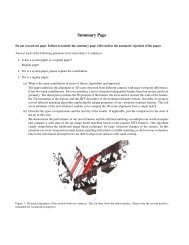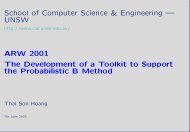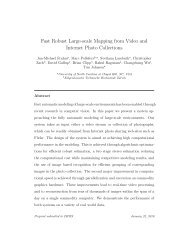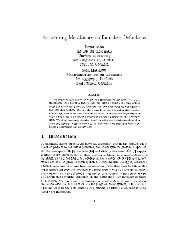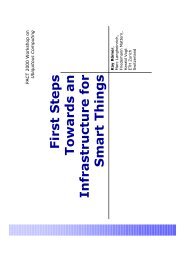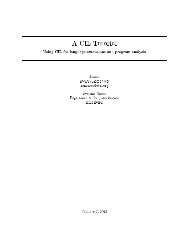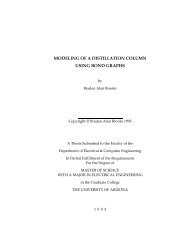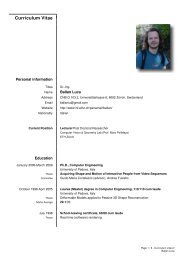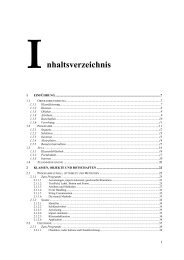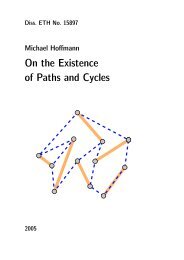From Hybrid Courses to Blended Learning: A Case Study
From Hybrid Courses to Blended Learning: A Case Study
From Hybrid Courses to Blended Learning: A Case Study
You also want an ePaper? Increase the reach of your titles
YUMPU automatically turns print PDFs into web optimized ePapers that Google loves.
SESSION 3: SOCIAL AND PEDAGOGICAL ISSUES<br />
FROM HYBRID COURSES TO BLENDED LEARNING: A CASE<br />
STUDY<br />
Hans Hinterberger, Lukas Fässler, Bettina Bauer-Messmer<br />
ETH Zürich, Institute of Computational Science, CH-8092 Zurich, Switzerland<br />
KEYWORDS: <strong>Blended</strong> learning, e-learning, application oriented learning, constructivism<br />
Abstract: To accommodate large classes and raise the motivation of natural science students<br />
taking an introduc<strong>to</strong>ry information and communication technology course, we introduced e-<br />
learning material. An analysis of the fac<strong>to</strong>rs that contribute <strong>to</strong> the course's success shows that<br />
it is not the application of technology in various forms that is responsible but the careful<br />
blending of different didactical methods, based on sound pedagogical principles. After we<br />
started using e-learning material based on active, application oriented, individualized<br />
learning, we noticed a remarkable increase in the student's motivation. They can apply<br />
conceptual knowledge more flexibly and work more independently with increasing self<br />
confidence.<br />
1. INTRODUCTION<br />
Already before the development of the World Wide Web and the e-learning-wave that<br />
followed in its wake, complaints were voiced that students have acquired extensive theoretical<br />
knowledge but that they cannot use this knowledge outside of school or university (Reimann-<br />
Rothmeier 1996). In other words, the acquired knowledge remains inactive. This deficiency<br />
cannot be repaired with electronic learning environments alone, no matter how ingenious they<br />
are, it is above all a pedagogical question of how <strong>to</strong> effectively transfer information.<br />
In this context we are interested in didactical methods that focus on result oriented learning.<br />
Bloom provides a useful scaffolding with his taxonomy of educational goals (Bloom, 1956),<br />
dividing cognitive training goals in<strong>to</strong> six classes (K1 - K6): knowledge, understanding,<br />
application, analysis, synthesis and evaluation. This taxonomy helps us guide our<br />
instructional efforts <strong>to</strong>wards clearly defined goals that describe different levels of a student's<br />
competency.<br />
In traditional scenarios of introduc<strong>to</strong>ry instruction, learners typically reach levels K1 and K2,<br />
an indication that knowledge will remain inactive. They are exposed <strong>to</strong> extended passiveness,<br />
learn superficially and without a long term view, while the lecturer aims <strong>to</strong> transfer a ready<br />
made "knowledge system". Many suggestions for reform (explora<strong>to</strong>ry learning,<br />
constructionalism in various flavors) therefore rely essentially on active, application oriented<br />
learning, in order <strong>to</strong> reach competency levels K3 and higher through active involvement of<br />
the learner. Interestingly, assessments often include problems requiring K3 competencies or<br />
higher even though the corresponding instruction only trained for levels K1 and K2.<br />
This paper reports experiences we made using e-learning with an introduc<strong>to</strong>ry ICT course<br />
(Information and Communication Technology) and summarizes lessons learned.<br />
The starting point<br />
We decided <strong>to</strong> redesign the ICT course six years ago, with the following goals in mind:<br />
incorporate active, application oriented learning, teach large classes without sacrificing<br />
individual support, provide the means for self controlled learning, and investigate the<br />
potential of e-learning course material.<br />
1
6. ICNEE, 27-30 September 2004, Neuchâtel / Switzerland<br />
In a kind of tight rope walk the course's content has <strong>to</strong> challenge students already experienced<br />
with computers while it avoids overtaxing those who lack these skills. The large number of<br />
students forces us <strong>to</strong> apply didactical concepts which can provide a maximum of support –<br />
particularly for less experienced students – with limited personal resources.<br />
The course Einsatz von Informatikmitteln (application of software <strong>to</strong>ols, www.evim.ethz.ch)<br />
is compulsory for students enrolled in eight natural science programs. Approx. 300 students<br />
have the course scheduled in the winter semester and 350 in the summer. During this course,<br />
students must acquire not only conceptual knowledge but also ICT skills and gain the<br />
confidence <strong>to</strong> apply them. This last point is crucial if we expect that students continue <strong>to</strong><br />
expand their ICT competencies.<br />
The course is structured as follows. Theoretical principles of ICT and the "big picture" are<br />
covered with a weekly two hour lecture. The class discussions are complemented with lecture<br />
notes. Every two weeks the students are given a new set of exercises which were originally<br />
organized as printed tu<strong>to</strong>rials, <strong>to</strong> be worked through at a student's own pace. The tu<strong>to</strong>rials –<br />
on average about 15 pages long – guide a student step by step through a problem that he or<br />
she solves with a given software application (e.g. a database program). At the end of each<br />
tu<strong>to</strong>rial, students are required <strong>to</strong> solve a different, but related problem independently and then<br />
demonstrate and explain the solution <strong>to</strong> a teaching assistant.<br />
Each student must complete a <strong>to</strong>tal of six tu<strong>to</strong>rials, covering the following <strong>to</strong>pics: internet<br />
publishing, simulation with spreadsheets, visualizing multivariate data, managing data with<br />
spreadsheets, managing data with a relational database, and macro programming.<br />
2. SUPPORTING ACTIVITIES WITH APPLICATION TUTORIALS<br />
Most instruc<strong>to</strong>rs, faced with the redesign of a course with large classes, will <strong>to</strong>day seriously<br />
consider using electronic media. In many cases this does perhaps solve the problem of<br />
quantity. There exists, however, this stubborn qualitative problem of the inactive knowledge.<br />
Trusting in application oriented learning <strong>to</strong> attack this problem we created written tu<strong>to</strong>rials <strong>to</strong><br />
guide students through six conceptually different application programs while solving a well<br />
defined task. At the center of this effort is the problem solving process, not the operation of<br />
the software.<br />
Each ICT application has its own tu<strong>to</strong>rial which is organized in<strong>to</strong> three parts as follows. First,<br />
an introduc<strong>to</strong>ry part gives a brief overview of the abstract concepts relevant for the<br />
application and introduces the important terms – complementary <strong>to</strong> the lecture, in which the<br />
corresponding theory is treated at a more general level. At this stage we relate ICT <strong>to</strong>pics with<br />
the (potentially) future scientific activities of the natural science students. The theoretical<br />
introduction is supported with a glossary that contains the applicable technical ICT terms.<br />
These documents span the student's learning space and give it a supporting structure.<br />
In the second part, students are given a series of tasks, each of which has been broken down<br />
in<strong>to</strong> a collection of small instructions, leading directly <strong>to</strong> practical activity. Perhaps the most<br />
challenging detail has been <strong>to</strong> find a way <strong>to</strong> "package" concepts in<strong>to</strong> a set of instructions<br />
which lead <strong>to</strong> activities that allow a student <strong>to</strong> construct his or her knowledge (a method<br />
known as constructivism), rather than just memorize it.<br />
The third part deals with assessment. A student is tested with a problem that he or she should<br />
be able <strong>to</strong> solve independently, with the knowledge and the skills learned while working<br />
through the tu<strong>to</strong>rial. As a feedback <strong>to</strong> the student, this test certifies her or his competency in a<br />
particular ICT application. At this stage the students interact with the teaching assistants,<br />
whose task is <strong>to</strong> verify authorship of the results and confirm that concept and theory have<br />
been correctly unders<strong>to</strong>od and been applied in the right context.<br />
2
SESSION 3: SOCIAL AND PEDAGOGICAL ISSUES<br />
Teaching assistants not only accept excercices in the computer rooms, it is also their duty <strong>to</strong><br />
be present at fixed times <strong>to</strong> provide support with the tu<strong>to</strong>rials, should the need arise.<br />
Active, application oriented learning motivates<br />
After we started using the tu<strong>to</strong>rials, we noticed a remarkable increase in the student's<br />
motivation. They are able <strong>to</strong> apply conceptual knowledge more flexibly, they work more<br />
independently with increasing self confidence and, whenever they consult teaching assistants,<br />
they do so primarily for problems relating <strong>to</strong> the application in the context of analysis and<br />
synthesis (K3 - K5). Course evaluations show that over 90% of the students react favorably <strong>to</strong><br />
these tu<strong>to</strong>rials. This positive qualitative shift in educational effort is possible because students<br />
are provided with material that allows them <strong>to</strong> learn elementary skills completely on their own<br />
as active learners. With over 300 students per semester, this gain in efficiency pays off.<br />
Some of the natural science programs require their students <strong>to</strong> pass an introduc<strong>to</strong>ry<br />
programming course. Because programming requires other skills and competencies than using<br />
standard ICT applications, we are currently adapting the design of the tu<strong>to</strong>rials conceptually<br />
and technically <strong>to</strong> meet these new requirements.<br />
3. HYBRID COURSES: ATTACHING E-LEARNING TO TRADITIONAL COURSES<br />
Tu<strong>to</strong>rials are prime candidates for e-learning because, when guiding people through a<br />
software application with written instructions, it stands <strong>to</strong> reason that the instructions<br />
themselves are presented on the same computer screen and furthermore include self-control<br />
elements. We started <strong>to</strong> develop hypertext-based tu<strong>to</strong>rials in the summer of 2000, supported<br />
by a research grant of ETH (Fonds Filep) and called the software application guides (see<br />
center of Fig.1).<br />
The didactical concept of the course remained unchanged, only the application guides were <strong>to</strong><br />
be available on the web. In hindsight we call this approach a hybrid course: adding a new<br />
technology <strong>to</strong> instruction which allows the paperless delivery of a tu<strong>to</strong>rial. The following<br />
summarizes the experiences we made with these and other ideas that came up while<br />
developing and using these electronic application tu<strong>to</strong>rials.<br />
Electronic textbook<br />
Once we decided <strong>to</strong> use hypertext documents, it seemed a logical extension <strong>to</strong> also create an<br />
electronic version of the lecture notes and link its content with the tu<strong>to</strong>rial and the glossary.<br />
We learned, however, that availability of information in itself is not a major problem when<br />
instructing. Linked hypertext pages and text databases with search facilities simply provide<br />
novel access but they do not reduce the complexity or the abundance of information.<br />
Our experience shows that with an application-oriented approach, the theory, necessary for a<br />
given concept, can be broken up in<strong>to</strong> doses with a depth that will allow students <strong>to</strong> construct<br />
an understanding while working through a concrete problem. The information, presented in<br />
detail in a textbook is <strong>to</strong>o remote from the information students require <strong>to</strong> solve their<br />
immediate pactical problems. Theory must therefore be reworked in<strong>to</strong> smaller units that relate<br />
<strong>to</strong> a concrete problem.<br />
Animations, videos<br />
To visually support the step by step instructions of the application guide, we first<br />
experimented with short video sequences. We realized, however, that animations and videos<br />
are instruc<strong>to</strong>r-centered and do not support the student's activity.<br />
3
6. ICNEE, 27-30 September 2004, Neuchâtel / Switzerland<br />
As soon as students themselves can control their learning process, animations and videos are<br />
no longer consulted. We observed that illustrations, which depict way points <strong>to</strong> be passed on<br />
the road <strong>to</strong> competency (intermediate results), have proven <strong>to</strong> be more effective.<br />
In other words, students do<br />
not want <strong>to</strong> watch a<br />
moving mouse pointer,<br />
they want <strong>to</strong> take the<br />
mouse in<strong>to</strong> their own hand,<br />
because they are expected<br />
in the end <strong>to</strong> solve a<br />
problem by themselves.<br />
Teaching assistance<br />
The presence of teaching<br />
assistants during fixed<br />
hours allows students <strong>to</strong><br />
build up a relationship<br />
with a real room and real<br />
persons. The role of the<br />
teaching assistant,<br />
however, has changed<br />
from information broker<br />
and example problem<br />
solver <strong>to</strong> coach (answering<br />
detailed questions,<br />
controlling learning<br />
progress, providing<br />
feedback).<br />
This also animates<br />
students <strong>to</strong> more<br />
frequently help each other<br />
out, finding answers <strong>to</strong><br />
many small questions by<br />
themselves, thus making<br />
other mechanisms <strong>to</strong><br />
support collaborative work<br />
superfluous.<br />
Time management<br />
In general, students spend<br />
more time with our e-<br />
learning material, are more<br />
motivated and work less<br />
superficial than they did<br />
with traditional methods.<br />
They do not save time<br />
during the semester,<br />
however, because they<br />
deal intensively with<br />
material which before they<br />
used <strong>to</strong> work through just<br />
prior <strong>to</strong> the exams.<br />
Figure 1. The structure of an application oriented tu<strong>to</strong>rial. Concepts<br />
combined with skills for different software applications lead <strong>to</strong> independent<br />
ICT-competencies. The interface <strong>to</strong> the application guides consists of three<br />
windows: one running an application, another with instructions <strong>to</strong> guide<br />
users through an exercise, a third in which expected outcomes or<br />
supportive information can be displayed. The paper-based introduction <strong>to</strong><br />
concepts and technical terms spans the space of the learning process.<br />
4
SESSION 3: SOCIAL AND PEDAGOGICAL ISSUES<br />
Saving time should not be an important pedagogical goal in our opinion anyway; but <strong>to</strong> better<br />
distribute activities such that time can be effectively utilized should be.<br />
Media<br />
The only e-learning material we provide are conceptually well structured instructions<br />
(application guides) that not only lead <strong>to</strong> certain skills but through subtle integration of theory<br />
lead <strong>to</strong> ICT-competencies. To work with the application guides, which can be called up on the<br />
web, one only needs a browser. The e-learning material is also available on a CD-ROM for<br />
those who cannot or want not spend time on the internet. Interestingly, given the choice, most<br />
students prefer the CD-ROM over the web (even when they have free internet access in the<br />
schools computer rooms). Virtuality is hard <strong>to</strong> sell.<br />
Quality control<br />
The course's acceptance is evaluated regularly with questionaires which include the lecture,<br />
the tu<strong>to</strong>rials and the assessment, because only then can students judge their learning progress<br />
accurately (see: http://www.evim.ethz.ch/appliguide/evim_evaluation.htm). The course's<br />
effectiveness is evaluated with an application-oriented test at the end of the semester. These<br />
output-oriented assessments provide us with a realistic estimate of what students actually<br />
learned in our course.<br />
The most useful feedback <strong>to</strong> control the course's quality results from the 10 minute verbal<br />
assessment session at the end of each tu<strong>to</strong>rial during which students explain <strong>to</strong> a teaching<br />
assistant how they solved the tu<strong>to</strong>rial's final problem. These assessments show that students<br />
are not only more motivated, they also learn more. As part of its redesign, the observable<br />
output has become the dominant quality criterion.<br />
The course's quality has also been confirmed indirectly through the fact that students were<br />
spontaneously asking for application guides in the programming courses that followed and<br />
showed disappointment when <strong>to</strong>ld that they have make do without them.<br />
Assessment<br />
To certify a student's competencies, we introduced verbal assessments for each tu<strong>to</strong>rial. The<br />
assistant's feedback becomes a reward for a student's efforts that counts much more than the<br />
credit points at the end of the semester.<br />
Our students must also pass a one hour exam at the end of the course. With traditional<br />
courses, students are often required <strong>to</strong> solve application oriented problems during an exam<br />
even though instruction seldom passed beyond K2. The resulting failure rates often tempt the<br />
instruc<strong>to</strong>r <strong>to</strong> fix averages by adjusting the grading scale accordingly. Application oriented<br />
learning makes it possible <strong>to</strong> raise the questions of an exam <strong>to</strong> levels K3 and higher, reducing<br />
this side effect. We have become convinced that if instruction and assessment are <strong>to</strong> be<br />
effective, both must be designed for the same cognitive level.<br />
A future project will examine methods <strong>to</strong> electronically administer exams with individualized<br />
tests that include application oriented questions. The underlying database of questions will<br />
also be accessed during the course, allowing a close coupling of instruction with assessment<br />
so that students can verify their progress and become competent at the level of K3 and higher.<br />
4. BLENDED LEARNING: STRATEGICALLY INCORPORATING E-LEARNING<br />
The experiences described in Section 3 have led us beyond the simple change from paperbased<br />
<strong>to</strong> e-learning instruction. Several aspects of self-controlled learning made us<br />
unavoidably aware of the necessity <strong>to</strong> consider many didactical issues when introducing<br />
technology.<br />
5
6. ICNEE, 27-30 September 2004, Neuchâtel / Switzerland<br />
The term blended learning imposes itself <strong>to</strong> describe the pedagogical scenario necessary <strong>to</strong><br />
extend the positive experiences made with the online tu<strong>to</strong>rials <strong>to</strong> the entire lecture. An attempt<br />
at a definition of blended learning, as we understand it, might read as follows: An instruc<strong>to</strong>r<br />
supports blended learning if he or she includes in the curriculum socially supported<br />
interaction (e.g. classroom instruction), self-controlled instruction (e.g. e-learning material),<br />
assessment as feedback <strong>to</strong> students and instruc<strong>to</strong>r, and applies <strong>to</strong> all of them the same<br />
instructional strategy <strong>to</strong> define the targeted competence level.<br />
This is in contrast with current definitions of the term, such as "with blended learning,<br />
instructional designers divide a learning program in<strong>to</strong> modules and determine the best<br />
medium <strong>to</strong> deliver those modules", we call this modular learning. Or, "blended learning is a<br />
method of educating at a distance that uses technology, combined with traditional education",<br />
these we call hybrid courses. <strong>Blended</strong> learning, unders<strong>to</strong>od as a mix of old and new best<br />
practices in education has <strong>to</strong> be welcomed with the caveat that just mixing will not yield much<br />
of an improvemen, unless the right recipe has been found. Above all, it must support a<br />
learning style that leads <strong>to</strong> deeper and better knowledge acquisition.<br />
Supporting different learning styles<br />
Traditional methods of teaching typically produce two different learning styles: breadthoriented<br />
and depth-oriented learners. Breadth-oriented learners primarily scan course content<br />
and concentrate on their capacity <strong>to</strong> memorize with the goal <strong>to</strong> reproduce knowledge at a later<br />
time. Depth-oriented types want <strong>to</strong> work the material over in a way that will lead him or her<br />
<strong>to</strong> a fundamental understanding of the subject matter. Breadth-oriented learners will often<br />
pass traditional assessments successfully, because many can concentrate on the essentials and<br />
their knowledge will often be judged <strong>to</strong> be more precise because they have a large body of<br />
technical terms at their disposal.<br />
The depth-oriented type acquires a more sustainable strategy in dealing with a particular<br />
<strong>to</strong>pic, however. These students generally know fewer terms, but they can better describe the<br />
context in which a term exists and are more proficient at problem solving (K3 and higher).<br />
The application guides with their assessment strategy support depth-oriented learning. It can<br />
lead students <strong>to</strong> the insight that with such a strategy they become better problem solvers in the<br />
long term and will be better equipped for life long learning.<br />
SUMMARY<br />
The great potential of e-learning <strong>to</strong> deliver educational information can be profitably<br />
exploited if the underlying learning process leads <strong>to</strong> new skills and competencies. A careful<br />
combination of active applications, enriched with relevant concepts, can be successful if they<br />
are embedded in a blend whose elements (lecture, practice, and assessment) fit <strong>to</strong>gether. To<br />
this end, competency levels that apply <strong>to</strong> all of these elements must be defined.<br />
With e-learning, individualized instruction is possible also in large, heterogeneous classes. As<br />
a rule, however, it does not reduce cost and time. But it can raise the quality of instruction and<br />
motivate students <strong>to</strong> learn longer and more profoundly and, as a consequence, it prepares<br />
them better for continued education.<br />
Moving the problem solving procress instead of theory <strong>to</strong> the center, ideally supports<br />
constructivism and provides students with a structure that gives them the security <strong>to</strong> learn<br />
more effectively and expediently.<br />
6
SESSION 3: SOCIAL AND PEDAGOGICAL ISSUES<br />
REFERENCES<br />
BLOOM, B.S. (Ed). (1956). Taxonomy of Educational Objectives Handbook 1: Cognitive<br />
Domain. New York: Longman, Green & Co.<br />
REIMANN-ROTHMEIER, G., MANDEL. H. (1996). Lernen auf der Basis des<br />
Konstruktivismus. Computer und Unterricht 23, 1996, 41-44.<br />
7



